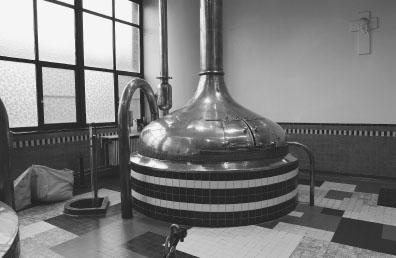Kettle, the vessel in which beer wort is boiled with hops. Proper wort boiling achieves a number of effects, including sterilization of the wort, denaturing of enzymes, extraction of hop components, coagulation of proteins and polyphenols, wort concentration, color development, and the driving off of unwanted volatiles. Modern kettles are designed to carry out these tasks in the most efficient manner possible while still yielding high-quality wort. In the UK, the kettle is often called a copper, named after the metal from which many kettles were once fashioned. Hundreds of years ago, the average brewery kettle was essentially a cast iron pot sitting over an open wood fire. Over time these were refined to include furnaces designed to concentrate heat onto the bottom boiling surfaces.
As brewing vessels became more complex, copper replaced iron. Copper is not as strong as iron, but it is more malleable, conducts heat far more efficiently, and resists corrosion better than iron does. Copper’s malleability gave rise to the elegant shape of the classical “onion-dome” kettle top, still widely seen in Europe. By the mid-20th century copper was largely replaced by stainless steel, which is stronger and far easier to clean and maintain using modern clean-in-place procedures.

Traditional copper kettle at the Westmalle Brewery in the Trappist Abbey of Westmalle, Belgium. photograph by denton tillman
Whatever the design, kettles must evaporate a consistent percentage of the kettle contents and provide sufficient mechanical agitation for protein coagulation and efficient hop extraction to take place. Steam jackets are placed within the kettle walls asymmetrically; thermal currents will set up a rolling boil that thoroughly mixes the kettle contents. Where a calandria is used, the wort will be moved through it, either by a pump or convectively, and dispersed back to the surface of the liquid by an adjustable spreader. Boiling usually takes place at ambient pressures, but some kettles are designed to boil at higher pressure and temperature. This can increase the efficiency of hop extraction, but it may also develop higher color and impede the volatilization of undesirable compounds.
In small breweries and brewpubs, the kettle may include a whirlpool function for the removal of trub and hop pellet fragments. In this case, the vessel will be referred to as a “kettle-whirlpool.”
Hops, minerals, kettle finings, brewer’s syrups, and other additions to the wort may be introduced through the kettle manway or by automated systems that discharge directly into the kettle. Many modern systems, seeking the best possible energy efficiency, will include a heat exchanger system within the kettle stack; the kettle steam is thereby used to heat more water for later use in the brewing process or cleaning.
